1. Exponential increases in computing power especially AI chips.
A gigaflop is conducting a billion transactions in a single second. In 1961 a gigaflop cost $153 billion on mainframes. In 2019 it cost a penny on a smartphone. Computing is basically free and it’s happening at the edge.
2. Data is exploding.
AI and machine learning (ML) require huge data sets to accurately identify patterns and make predictions. With the rise of the Internet of Things (IoT) and the generation of more data in the next two years than in all of human history combined, the data is too vast for humans to make sense of – but for AI and ML this is their feedstock.
3. The Plummeting Cost of Cloud Computing and Storage.
Amazon Web Services (AWS) has cut its prices 70 times since it launched in 2006. In 1995 it cost about $15 million to build the IT infrastructure for a Silicon Valley startup, notes Salim Ismail, Michael Malone and Yuri Van Geest in Exponential Organizations. By 2020 that cost dropped 750-fold to $20,000 using AWS, exponentially decreasing the risk for entrepreneurs and exponentially increasing the number of AI startups that will experiment to disrupt industries.
Are your products, services and business models getting smarter, better, safer and cheaper every day because of AI? Management consulting firm McKinsey says AI can add $13 trillion of additional economic value by 2030. We are about to go through the same transition with AI as we did with software. Early adopters will dominate those who delay.

Waymo has driven 10 million miles with its autonomous cars. The company has driven 10 billion miles in virtual reality. By comparison Tesla’s vehicles have driven two billion actual miles in autonomous mode.
The huge amounts of data give Waymo and Tesla powerful insight into improving autonomous driving and safety. Lessons that the AI learns in an individual car are relayed to the cloud, and improvements are shared with every other car in the next update. The AI for Waymo and the AI for Tesla are getting better, smarter and safer with each mile driven.
These data insights enable Tesla to offer Tesla owners in California car insurance at 20% to 30% less than traditional insurance companies. Tesla will eventually expand this beyond California. Tesla can innovate its business model (in this case entering the insurance market) because it has access to the driving data. It knows that its self-driving cars are safer than traditional cars with its insured losses a fraction of a traditional insurance company. In the long term, Tesla’s risk will be 16X less than traditional insurance companies – given that 94% of car accidents are due to driver error.
Jim Harris is the author of Blindsided. Follow him on Twitter @JimHarris.

I3, the flagship magazine from the Consumer Technology Association (CTA)®, focuses on innovation in technology, policy and business as well as the entrepreneurs, industry leaders and startups that grow the consumer technology industry. Subscriptions to i3 are available free to qualified participants in the consumer electronics industry.